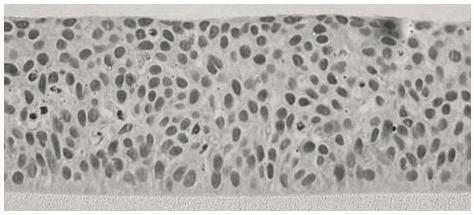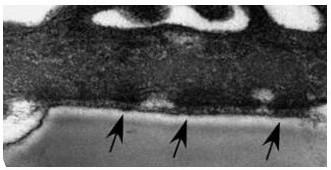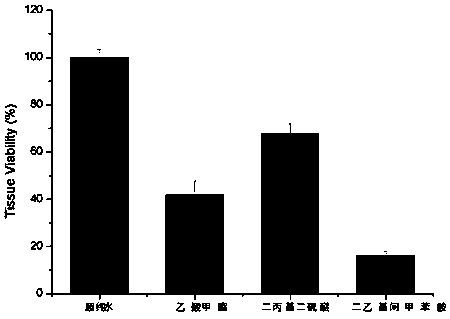Recombinant cornea model for ocular surface irritation evaluation and preparation method thereof
An irritating, corneal technology, applied in biochemical equipment and methods, tissue regeneration, tissue culture, etc., can solve the problems of abnormal gene phenotype, limited to laboratory culture, unable to apply corneal model, etc., to improve the accuracy. Effect
- Summary
- Abstract
- Description
- Claims
- Application Information
AI Technical Summary
Problems solved by technology
Method used
Image
Examples
Embodiment 1
[0045] The in vitro reorganized corneal epithelial model in this implementation uses the corneal stroma of animals to simulate the growth microenvironment of limbal stem cells, and proliferates and differentiates during the in vitro induction period to form a corneal epithelial reorganized model with 4 layers of normal corneal epithelial cell layered structure. Hemidesmosomal proteins with a structure similar to tight junctions in natural tissues are formed between model basal cells and cellular compartments.
[0046] The preparation method of the above-mentioned in vitro recombinant corneal epithelial model consists of the following steps:
[0047] 1. Preparation of limbal stem cells
[0048] The eyeballs from the eye bank were soaked in saline containing 1% gentamicin for 30 minutes, and the cornea was cut along the limbus to obtain limbal tissue. Rinse the limbal tissue two or three times with D-Hank's solution. Cut the cleaned limbal tissue into 2 mm square tissue pieces...
Embodiment 2
[0056] The in vitro corneal epithelial model of this implementation adopts the corneal stroma layer of animals to simulate the growth microenvironment of limbal stem cells, and proliferates and differentiates during the in vitro induction period to form a corneal epithelial reorganization model with a layered structure of 6 layers of epithelial cells. Hemidesmosomal proteins with a structure similar to tight junctions in natural tissues are formed between model basal cells and cellular compartments.
[0057] Its preparation method is as follows:
[0058] 1. Preparation of limbal stem cells
[0059] This step is the same as in Example 1.
[0060] 2. In vitro culture and expansion of limbal stem cells
[0061] Take 10ml of the above-mentioned limbal stem cell cell suspension and 200mg of the corneal stromal microcarriers prepared in step 2 and inject into the rotary culture system with a capacity of 30ml, set the rotation speed at 30 rpm, change the medium with fresh DMEM ever...
Embodiment 3
[0067] The in vitro recombinant corneal epithelial model implemented in this implementation uses the corneal stroma layer of animals to simulate the growth microenvironment of corneal limbal stem cells, obtains large-scale expansion of corneal limbal stem cells, and uses corneal limbal stem cells and corneal epithelial cells to proliferate and differentiate in vitro. A model of corneal epithelial reorganization in layered cell hierarchy. Hemidesmosomal proteins with a structure similar to tight junctions in natural tissues are formed between model basal cells and cellular compartments.
[0068] 1. Preparation of limbal stem cells
[0069] This step is the same as in Example 1.
[0070] 2. In vitro culture and expansion of limbal stem cells
[0071] This step is the same as in Example 1.
[0072] 3. Construction of in vitro heavy corneal epithelial model
[0073] 3.1 Resuspend the limbal stem cells obtained in step 2 with culture medium SK1, inoculate in a cell chamber with...
PUM
 Login to View More
Login to View More Abstract
Description
Claims
Application Information
 Login to View More
Login to View More - R&D
- Intellectual Property
- Life Sciences
- Materials
- Tech Scout
- Unparalleled Data Quality
- Higher Quality Content
- 60% Fewer Hallucinations
Browse by: Latest US Patents, China's latest patents, Technical Efficacy Thesaurus, Application Domain, Technology Topic, Popular Technical Reports.
© 2025 PatSnap. All rights reserved.Legal|Privacy policy|Modern Slavery Act Transparency Statement|Sitemap|About US| Contact US: help@patsnap.com



